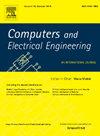基于高质量交错微带电感的能量收集系统双波段高效整流器
IF 4
3区 计算机科学
Q1 COMPUTER SCIENCE, HARDWARE & ARCHITECTURE
引用次数: 0
摘要
提出了一种基于高质量微带电感的新型高效双带倍压整流器,用于低功耗能量采集系统。建议的设计工作在两个频段,第一个频段使用开槽的径向短管和一个新颖的高质量交错8形微带电感匹配,工作在1ghz,而第二个频段使用连接到二极管阳极的现成电感匹配,工作在1.3 GHz。新的交错电感具有紧凑的尺寸和高质量因数的优点,面积减少了70%,同时在1ghz时保持120的质量因数和22 nH的电感。与使用1的电感宽度比的传统电感不同,该电感采用1.42的宽度比来最大化q因子。采用带圆形槽的径向短桩提高输入反射系数,提高转换效率,提高直流输出电压。在1.3 GHz的第二个频段匹配是由一个真实的离散电感连接到二极管阳极,考虑到电感寄生电容匹配该频段。所提出的VD整流器的模拟效率为72%,饱和输出直流电压为3.5 V,而测量的RF-DC效率为61%,饱和电压为3.5 V,在-10 dBm输入功率(引脚)下,1 GHz和1.3 GHz频段的测量效率分别为46%和37%。在-10 dBm输入功率下测量的直流电压为0.6 V,双频段为0.53 V。建议的倍压整流器占用的PCB板尺寸为2.6cm×1.8cm (4.9cm2)。本文章由计算机程序翻译,如有差异,请以英文原文为准。
A dual-band high-efficiency rectifier based on high-quality interleaved micro-strip inductor for energy harvesting systems
A novel high-efficiency dual-band voltage doubler (VD) rectifier based on a high-quality micro-strip inductor is proposed for low-power energy harvesting (EH) systems. The suggested design operates in two frequency bands, the first band is matched utilizing slotted radial stubs and a novel high-quality interleaved 8-shaped micro-strip inductor to work at 1 GHz, while the second band is matched employing an off-the-shelf inductor connected to a diode anode to operate at 1.3 GHz. The new interleaved inductor provides the benefits of a compact size and high-quality factor, reducing area by 70 %, while maintaining a quality factor of 120 and an inductance of 22 nH at 1 GHz. Unlike conventional inductors that use an inductor width ratio of 1, the proposed inductor employs a width ratio of 1.42 to maximize the Q-factor. The radial stubs with circular slots are employed to improve the input reflection coefficient, enhance conversion efficiency, and increase the DC-output voltage. The second band matching at 1.3 GHz is obtained by a real discrete inductor linked to the diode anode, considering the inductor parasitic capacitance to match this band. The proposed VD rectifier achieves an extreme simulated efficiency equal to 72 %, a saturated output DC-voltage equal to 3.5 V, while the extreme measured RF-DC efficiency is equal to 61 %, saturated voltage equal to 3.5 V, and the measured efficiency at -10 dBm input power () is 46 % and 37 % for frequency bands of 1 and 1.3 GHz. The measured DC-voltage at -10 dBm input power is 0.6 V and 0.53 V for dual bands. The suggested voltage doubler rectifier occupies a PCB board size of ().
求助全文
通过发布文献求助,成功后即可免费获取论文全文。
去求助
来源期刊

Computers & Electrical Engineering
工程技术-工程:电子与电气
CiteScore
9.20
自引率
7.00%
发文量
661
审稿时长
47 days
期刊介绍:
The impact of computers has nowhere been more revolutionary than in electrical engineering. The design, analysis, and operation of electrical and electronic systems are now dominated by computers, a transformation that has been motivated by the natural ease of interface between computers and electrical systems, and the promise of spectacular improvements in speed and efficiency.
Published since 1973, Computers & Electrical Engineering provides rapid publication of topical research into the integration of computer technology and computational techniques with electrical and electronic systems. The journal publishes papers featuring novel implementations of computers and computational techniques in areas like signal and image processing, high-performance computing, parallel processing, and communications. Special attention will be paid to papers describing innovative architectures, algorithms, and software tools.
 求助内容:
求助内容: 应助结果提醒方式:
应助结果提醒方式:


